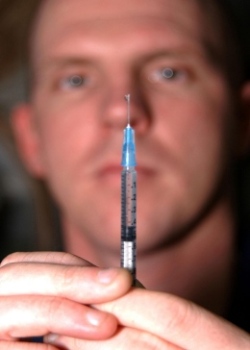Jan 28 2013
Paul Baumann, a sophomore mechanical and aerospace engineering major, couldn’t celebrate his four-year anniversary with his girlfriend. The plans were in place but something prevented him from setting foot outside his house: the flu.
 Although the flu epidemic has recently been declared a public health emergency, there have only been two diagnosed cases through UB's Student Health Services. While it has been reported students have disregarded the flu vaccine, experts at UB stress it's a vital preventative measure to the virus. Courtesy: Military Health System
Although the flu epidemic has recently been declared a public health emergency, there have only been two diagnosed cases through UB's Student Health Services. While it has been reported students have disregarded the flu vaccine, experts at UB stress it's a vital preventative measure to the virus. Courtesy: Military Health System
Baumann accounts for one of approximately 19,000 reported cases of the flu throughout New York State, according to cbsnews.com. The number is reportedly five times higher than last year. New York State Governor Andrew Cuomo declared the flu epidemic a public health emergency.
While there have only been two diagnosed cases of influenza at UB, according to Paula Taton, clinic manager at UB Student Health Services, the Centers for Disease Control and Prevention (CDC) has stated this year’s flu season is expected to be one of the worst in the last 10 years.
While the dangers of the flu virus are well known, much of the population is unaware of exactly how influenza affects the body and the immune system, which is something Brian MacDonald, a researcher within the microbiology and immunology department, studies specifically.
Many people do not know when someone dies from influenza, he or she does not do so because of the flu virus; it’s because of a bacterial infection.
The bacteria can be in your body for decades – in the nose or throat, for example – and not cause a problem. But after the influenza virus is contracted and the immune system is compromised, the bacteria can cause secondary pneumonia, which in turn can lead to death, according to MacDonald.
The defense against the flu begins with the flu vaccine, but it isn’t perfect, according to MacDonald. Approximately 38 percent of people who receive the shot are still at risk for infection.
The vaccine does not produce antibodies for every strain of influenza, which is why even after receiving the shot someone can still contract the virus.
“These experts at the CDC say, OK, I think it’s going to be strains one, two and three this year, so that’s what we’re going to make the vaccine protect people against,” MacDonald said. “But it’s a guessing game; so if it’s one, two and five and you get the vaccine, you’re not protected against three and five.”
But no matter which strain, “[if] you go to the doctor, they’re not going to do genetic testing to see which one you’ve got; they just want to make you better,” according to MacDonald.
Through his research, MacDonald works toward altering the body’s immune response to influenza through different techniques and compounds. He works to target the host immune response rather than the incoming virus.
“In a nutshell, what I am studying is: how does the influenza virus alter your immune response and how does this alternation put you at risk for secondary pneumonia, bacteria that typically wouldn’t cause a problem?” MacDonald said. “So it’s a matter of what do you want to do. Do you want to give a drug to fight the bug or do you want to give a drug that really educates or alters what the body’s response is to that drug?”
The immune system is similar to football or chess, according to MacDonald, because “you put different players on the field, they all have different capabilities and abilities and they have different roles.”
In collaboration with two other doctors – one of whom is Paras Prasad, a SUNY distinguished professor in chemistry, physics, electrical engineering and medicine – MacDonald uses nanoparticles made of raw material from shellfish – which is both cheap and nontoxic –as “a Trojan horse.”
“We coat these nanoparticles with RNA – ribonucleic acid – which looks like influenza RNA,” MacDonald said. “So it triggers an immune response to limit viral infection. And by limiting viral infection, you hopefully limit the risk of secondary pneumonia from the bacteria.”
While MacDonald’s research focuses on the immune system’s response to the flu, he believes everyone should get the flu shot, citing the adage “prevention is better than treatment.” He describes vaccine as “Velcro.”
“If the flu virus comes down your throat and goes to infect your lungs, it sticks to the cells and infects them,” MacDonald said. “The antibodies pretty much coat the outside of the virus so they can no longer stick, so it pretty much neutralizes the virus.”
The vaccine activates the immune system, which responds by making antibodies, and according to MacDonald, “the more you educate your immune system, the more things you show it how to fight, [that’s] just the smartest thing to do.”
Taton agrees, stating the flu shot has a 60 to 70 percent protection rate and, “helps prevent you from spreading the flu to your friends and family members – especially the very young and very old, who are at the highest risk for influenza and its consequences.”
If registered UB students have not received a flu shot and still wish to do so, they are able to receive a free flu vaccine through Student Health Services.